 |
 |
 |
| |
Switching From NNRTI to DTG-Even With Same NRTIs-Superior to PI
|
| |
| |
2022 CROI, February 12-16 and 22-24, 2022
Mark Mascolini
Switching from a first-line nonnucleoside (NNRTI) regimen to the integrase inhibitor dolutegravir (DTG) with different-or the same-nucleos(t)ide reverse transcriptase inhibitors (NRTIs) proved superior to switching to a protease inhibitor (PI) with new NRTIs at 48 weeks in the Zambian VISEND trial [1]. Results of both VISEND and a 7-country African trial, NADIA (pasted below), question World Health Organization advice to swap first-line tenofovir disoproxil (TDF) for zidovudine (ZVD) in a second-line regimen.
Women who switched to DTG and tenofovir alafenamide (TAF) in VISEND gained more weight than people who switched to DTG and tenofovir disoproxil (TDF) or to a boosted PI plus zidovudine/lamivudine (ZDV/3TC).
The World Health Organization recommends swapping NNRTI regimens for a DTG-based combination because of widening resistance to NNRTIs. To help guide this transition, researchers from Lusaka’s University Teaching Hospital and other centers conducted this comparison of switch strategies in people with a viral load below or above 1000 copies.
The 144-week randomized, open-label, noninferiority trial enrolled 1201 participants taking a first-line NNRTI regimen with a viral load below or above 1000 copies. Those with a sub-1000 viral load got randomized to TDF/3TC/DTG or TAF/3TC/DTG. People with a viral load above 1000 copies got randomized to TDF/3TC/DTG, TAF/3TC/DTG, ZDV/3TC/lopinavir/ritonavir (LPV/r) or ZDV/3TC/atazanavir/ritonavir (ATV/r). The primary endpoint was proportion of people with a viral load below 1000 copies at 144 weeks by FDA snapshot analysis.
Among people starting the trial with a viral load under 1000 copies, median age stood at 44 in both treatment arms. People randomized to TDF/3TC/DTG versus TAF/3TC/DTG included a higher proportion of women (65% vs 56%) but had a similar body mass index (23 and 22 kg/m2) and a similar proportion with a viral load below 50 copies (81% and 78%).
At 48 weeks the intention-to-treat (ITT) FDA snapshot analysis determined that 86% randomized to the TAF regimen and 88% randomized to the TDF regimen had a viral load below 1000 copies. In a per-protocol analysis, 98% in both study arms had a sub-1000-copy viral load. Proportions with a 48-week viral load below 50 copies in an ITT FDA snapshot were 76% taking the TAF combination and 81% taking the TDF regimen. Respective proportions below 50 copies at week 48 in a per-protocol analysis were 86% and 90%. Neither regimen was superior to the other for either viral load endpoint at 48 weeks. The TAF regimen was noninferior to the TDF regimen for either a sub-1000-copy or sub-50 copy viral load at week 48..
Among people who entered the trial with a viral load above 1000 copies, age averaged about 38 across the four study arms, about 60% were women, and body mass index averaged 21 kg/m2. About one quarter of participants had a viral load above 100,000 copies.
In the 48-week ITT FDA snapshot, proportions with a viral load below 1000 copies were 88% in the TAF/3TC/DTG group, 83% in the TDF/3TC/DTG group, 82% in the ZDV/3TC/ATV/r group, and 69% in the ZDV/3TC/LPV/r group. Those results meant that both DTG regimens were virologically superior to either PI regimen (difference 12.1 for TAF/3TC/DTG vs PI, difference 6.6 for TDF/3TC/DTG vs PI).
In the 48-week ITT FDA snapshot, proportions with a viral load under 50 copies were 82% with TAF/3TC/DTG, 72% with TDF/3TC/DTG, 71% with ZDV/3TC/ATV/r, and 56% with ZDV/3TC/LPV/r. Those numbers meant that in people randomized with a viral load above 1000 copies/mL, TAF/3TC/DTG was superior to TDF/3TC/DTG (difference 9.9), TAF/3TC/DTG was superior to ZDV/3TC with either PI (difference 18.0), and TDF/3TC/DTG was superior to ZDV/3TC with either PI (difference 8.1).
Women (but not men) switching to TAF/3TC/DTG gained more weight through 48 weeks (average 4.8 kg) than those trading off to TDF/3TC/DTG (average 2.8 kg) or ZDV/3TC/PI/r (average 2.4 kg).
VISEND investigators believe their results support using TDF/DTG with either 3TC or FTC when switching from a first-line NNRTI combination with a viral load either below or above 1000 copies. They proposed that either TDF or TAF can be maintained in a second-line regimen with DTG when swapping out a first-line NNRTI.
Reference
1. Mulenga LB, Sombo Fwoloshi S, Mweemba A, et al.. Dolutegravir with recycled nRTIs is noninferior to PI-based ART: VISEND trial. 2022 CROI, February 12-16 and 22-24, 2022. Abstract 135.
African NADIA Trial Favors 2nd-Line TDF Over ZDV, and DRV/r Over DTG
2022 CROI, February 12-16 and 22-24, 2022
Mark Mascolini
Two African randomized trials presented at CROI-NADIA and VISEND-cast doubt on World Health Organization (WHO) antiretroviral therapy (ART) advice to switch from tenofovir disoproxil (TDF) to zidovudine (ZDV) in second-line regimens [1,2]. In NADIA second-line regimens including TDF/3TC proved virologically superior to those relying on ZDV/3TC, and resistance concerns arose with dolutegravir (DTG) but not with darunavir/ritonavir (DRV/r) [1].
In the Zambian VISEND trial (reviewed separately below), among people with a viral load above 1000 copies on first-line ART with a nonnucleoside (NNRTI) plus two nucleos(t)idea, usually including TDF, after 48 weeks those who kept TDF and added the integrase inhibitor DTG had virologically superior results compared with people who switched to a boosted protease inhibitor (PI), ZVD, and lamivudine (3TC) [2].
NADIA aimed to compare virologic response and safety in people switching from a failing first-line NNRTI (efavirenz) regimen to either DTG or the PI DRV/r plus either TDF/3TC or ZDV/3TC [1]. The NADIA team previously reported 48-week results showing DTG virologically noninferior to DRV/r and TDF/3TC noninferior to ZDV/3TC [3]. But 4 cases of resistance to DTG emerged versus no resistance to DRV/r.
NADIA enrolled people with virologic failure (viral load above 1000 copies) while taking efavirenz, TDF, and 3TC or emtricitabine (FTC). The main outcome was a viral load below 400 copies at week 96 according FDA snapshot analysis.
The trial enrolled 464 people from 7 sites in Uganda, Kenya, and Zimbabwe. Most participants, 61%, were women, CD4 count lay below 200 in 51%, and viral load topped 100,000 copies in 28%. Proportions of trial enrollees with initial intermediate or high-level resistance were 59% for TDF, 18% for ZDV, and 92% for 3TC. Participants attended more than 98% of scheduled visits and spent more than 95% of follow-up time taking their assigned regimen.
At week 96 proportions with a viral load below 400 copies were 89.8% assigned to DTG and 86.9% assigned to DRV/r, a nonsignificant difference (P = 0.332). Nor did the groups differ significantly in proportion with a week-96 viral load below 50 copies or viral rebound above 1000 copies.
But 96-week sub-400-copy response did differ significantly between people randomized to TDF versus ZDV (91.8% vs 84.8%, difference 7.0, 95% confidence interval [CI] 1.2 to 12.8, P = 0.019). This finding indicated superiority of maintaining TDF/3TC versus switching to ZDV/3TC. A higher proportion taking TDF than ZDV had a viral load below 50 copies at week 96, but that difference lacked statistical significance (80.7% vs 74.9%, P = 0.133). Viral rebound above 1000 copies proved significantly less frequent with TDF than with ZDV (5.6% vs 14.3%, P = 0.002).
In subgroup analyses, TDF was virologically more effective than ZDV when the TDF-related K65R/N mutation was absent but not present at baseline; when the 3TC- or FTC-related M184V/I mutation was absent but not present at baseline; when participants had no or low tenofovir resistance at baseline but not intermediate or high resistance, and when people had no or low ZDV resistance at baseline but not intermediate or high ZDV resistance.
A higher proportion randomized to DTG than to DRV/r had an adverse event leading to stopping the study (1.7% vs 0.4%), but the groups did not differ much in rates of grade 3 or 4 events related to study drug (1.3% and 1.3%) or serious adverse events (7.7% and 7.0%). People randomized to ZDV rather than TDF had a higher rate of grade 3 or 4 adverse events related to study drug (2.2% vs 0.4%).
With 80% of viral sequences analyzed for resistance mutations, 6 people randomized to DTG acquired intermediate or high-level resistance to the integrase inhibitor, 2 of them after study week 48 and 5 of them in people also taking ZDV. No resistance to DRV has yet emerged in this study.
The NADIA team concluded that DTG plus 2 NRTIs yields durable HIV suppression as a second-line regimen. But because virologic response rates are equivalent with DRV/r and resistance risk is lower with the boosted PI, the investigators proposed that DRV/r plus 2 NRTIs should be preferred over DTG in second-line therapy in people like those in this trial. Because maintaining TDF/3TC in the regimen proved virologically superior to switching to ZDV/3TC, the researchers concluded that WHO guidelines recommending switching from TDF/3TC to ZDV/3TC in second-line therapy “should be reconsidered.”
References
1. Paton N, Musaazi J, Kityo C, et al. Nucleosides and darunavir/dolutegravir in Africa (NADIA) trial: outcomes at 96 weeks. 2022 CROI, February 12-16 and 22-24, 2022. Abstract 137.
2. Mulenga LB, Sombo Fwoloshi S, Mweemba A, et al.. Dolutegravir with recycled nRTIs is noninferior to PI-based ART: VISEND trial. 2022 CROI, February 12-16 and 22-24, 2022. Abstract 135.
3. Paton NI, Musaazi J, Kityo C, et al. Dolutegravir or darunavir in combination with zidovudine or tenofovir to treat HIV. N Engl J Med 2021;385:330-341. doi: 10.1056/NEJMoa2101609. https://www.nejm.org/doi/10.1056/NEJMoa2101609
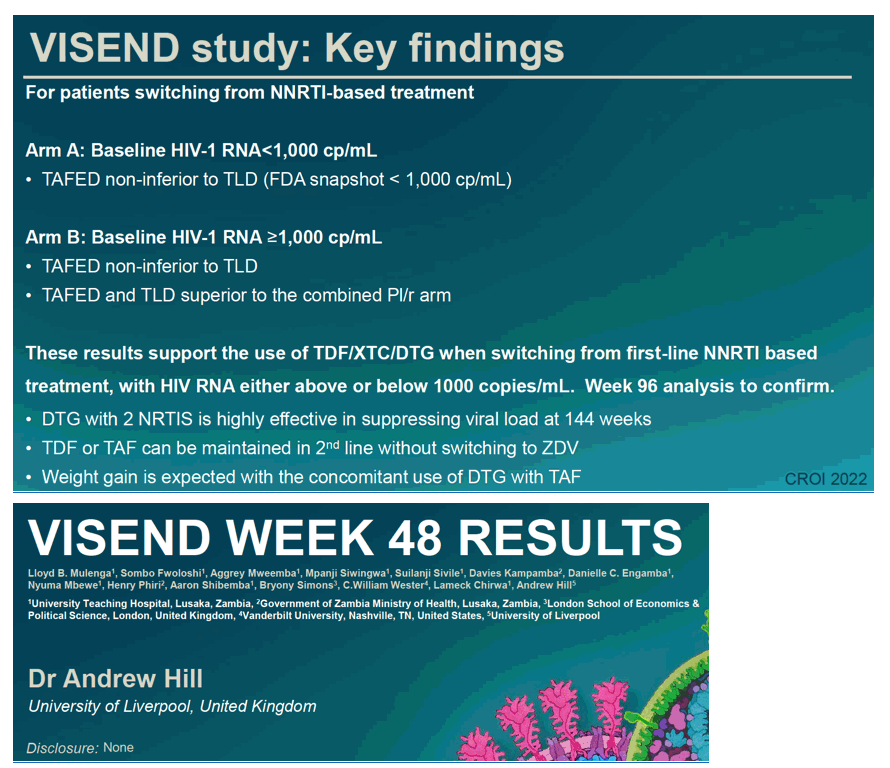
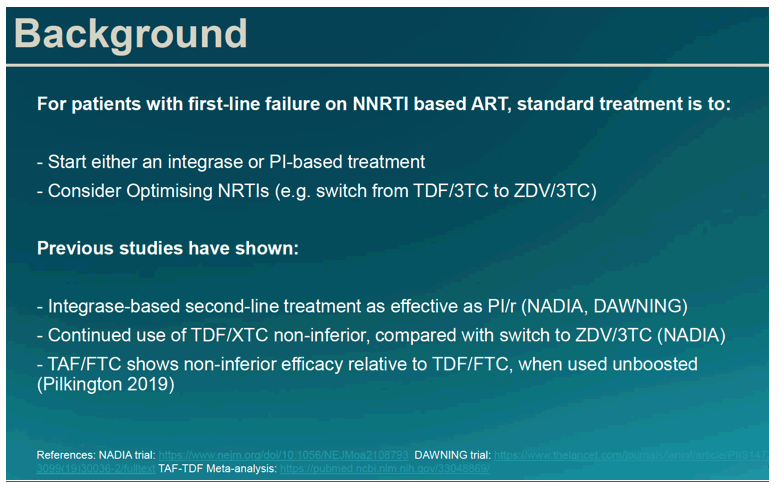
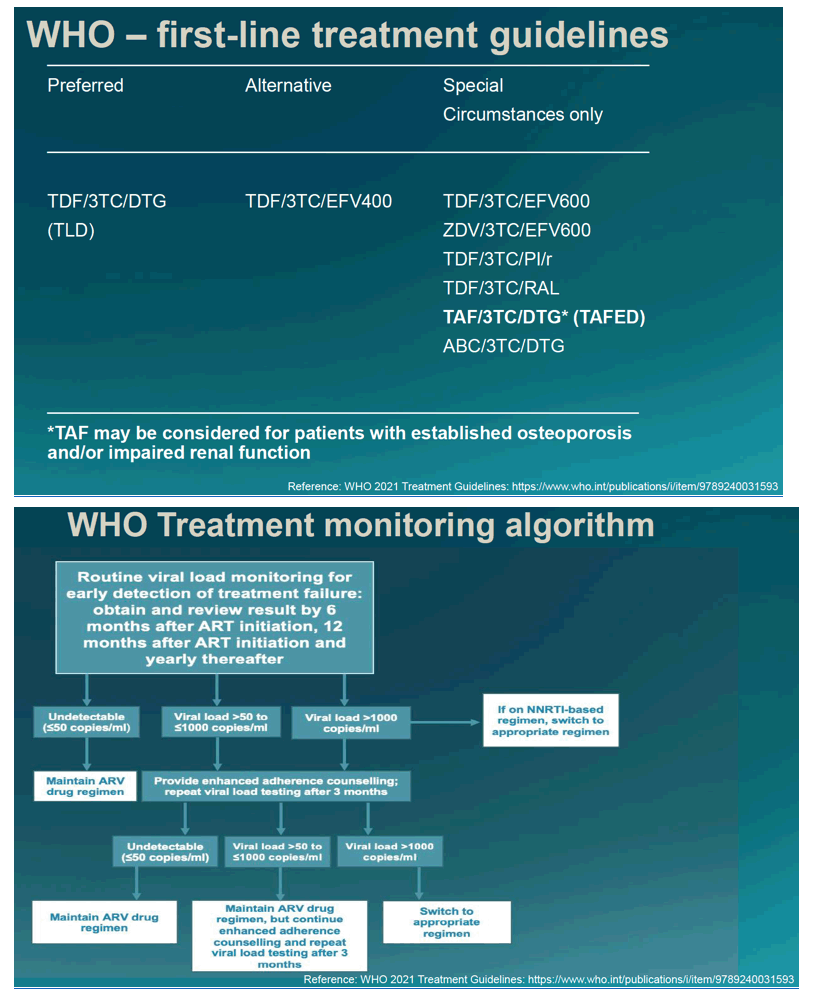
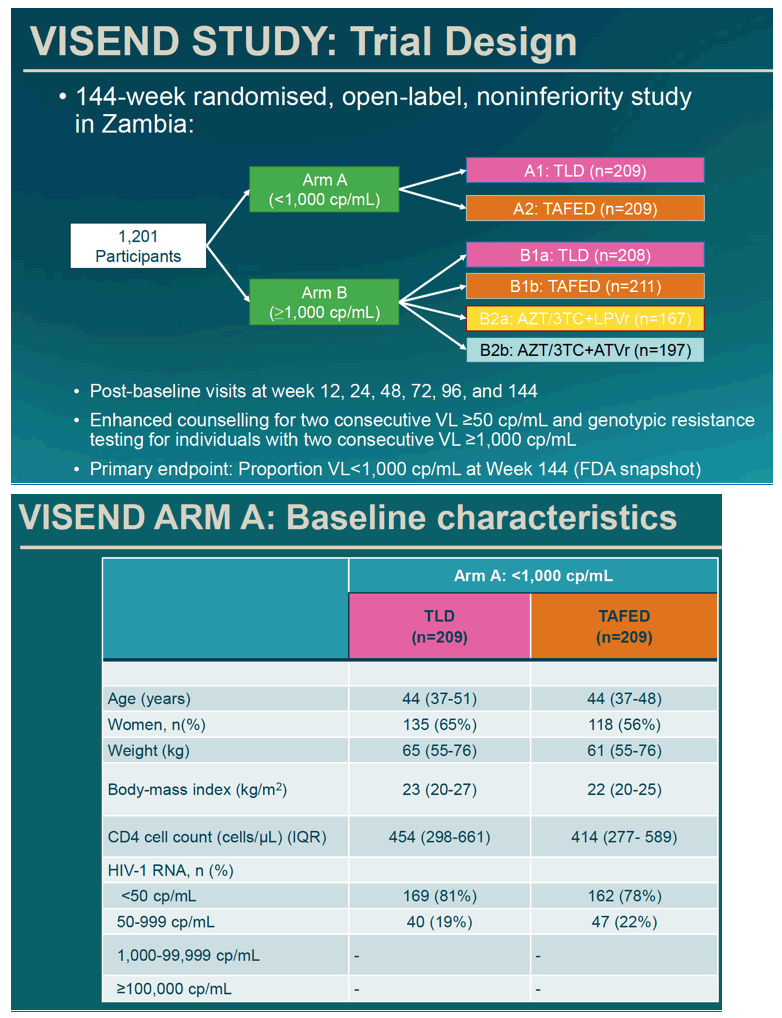
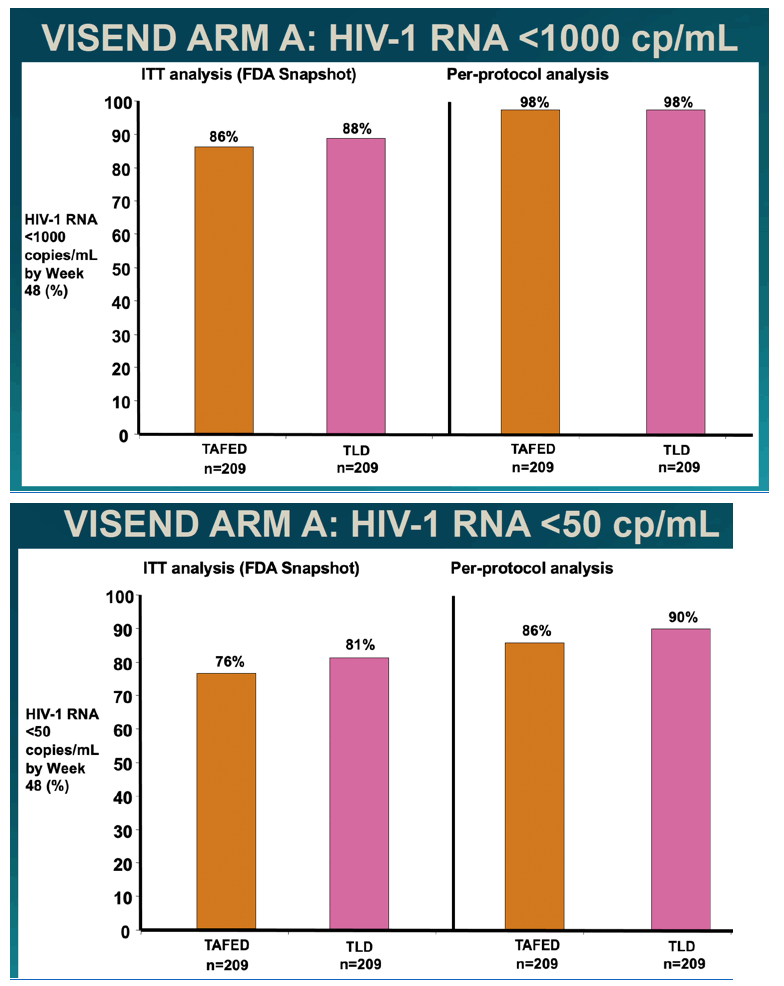
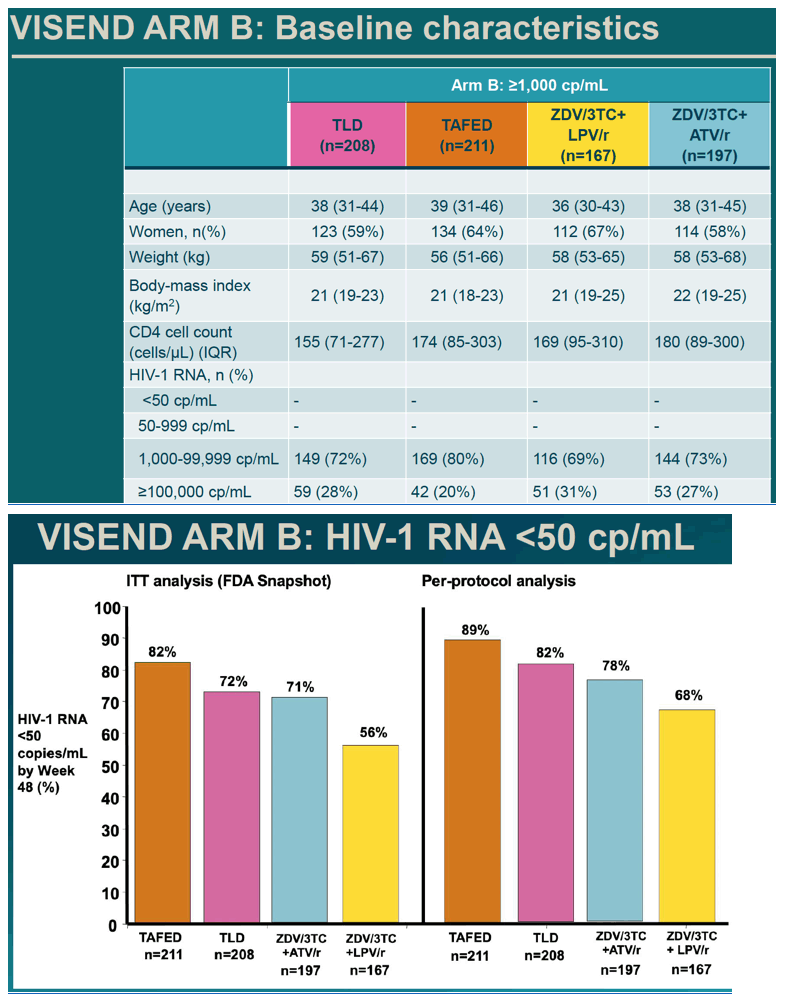
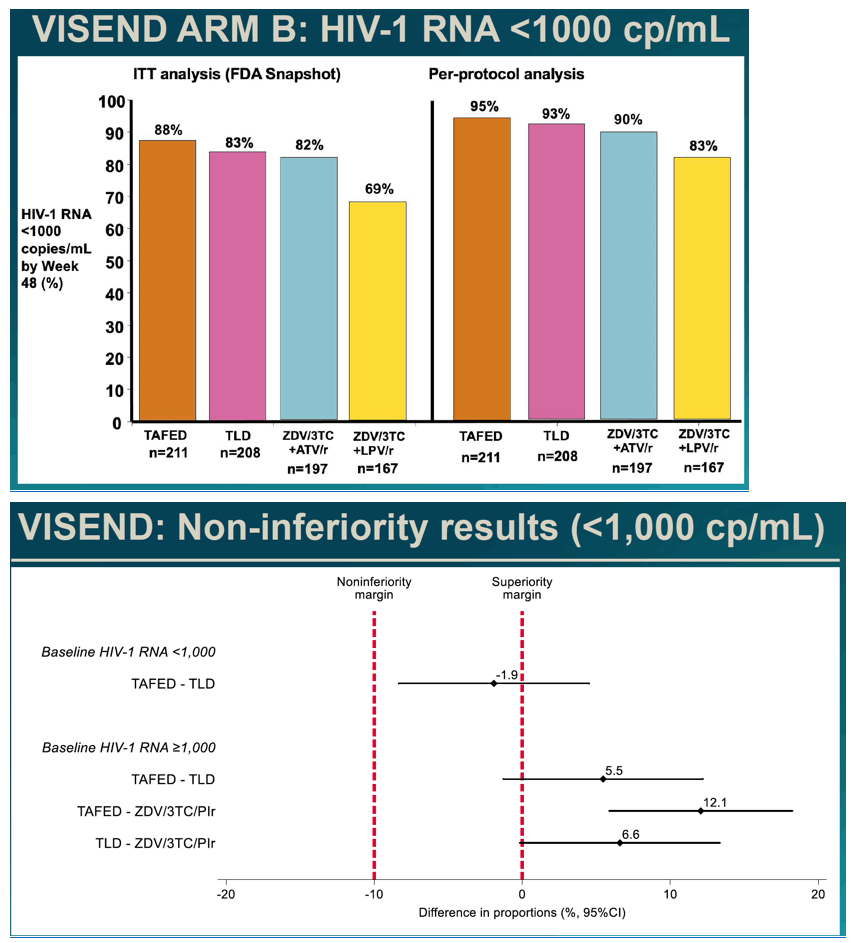
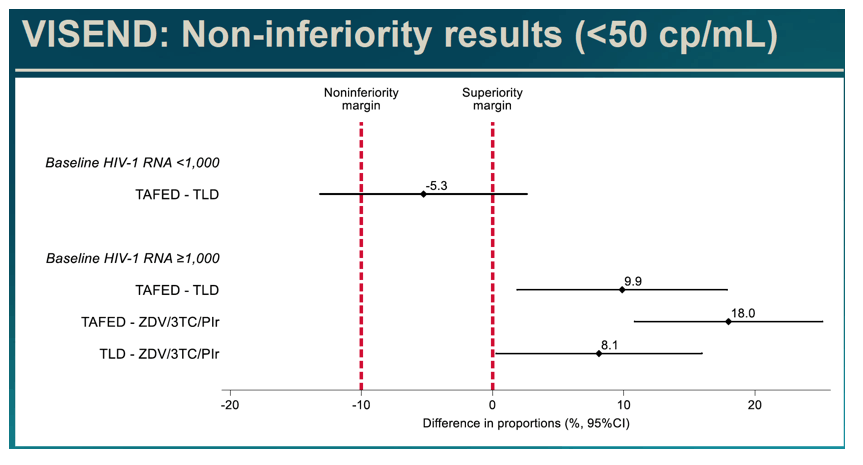
|
| |
|
 |
 |
|
|